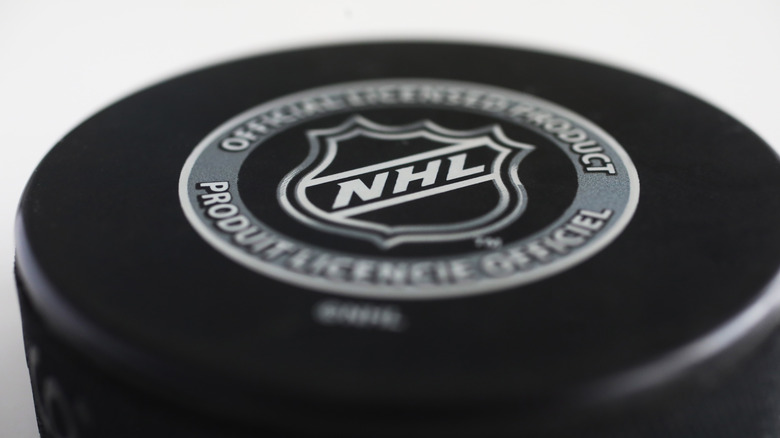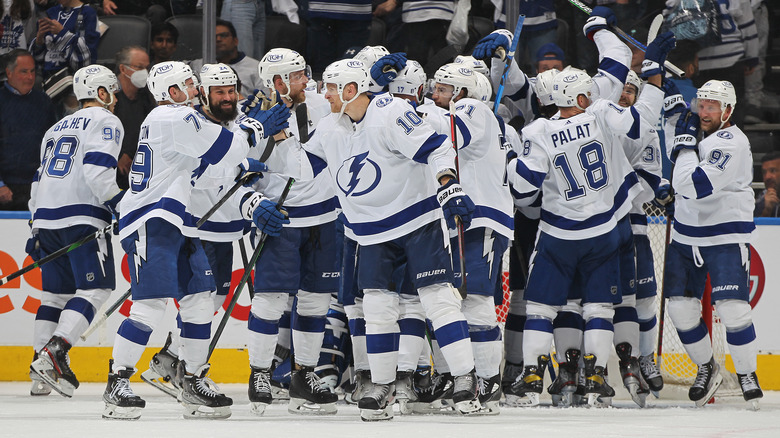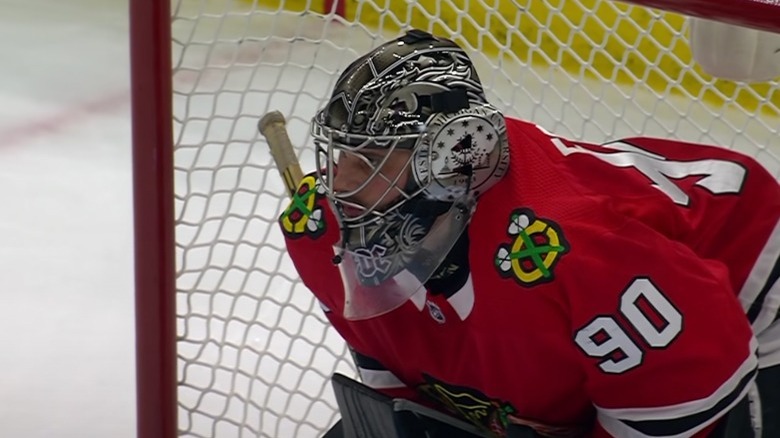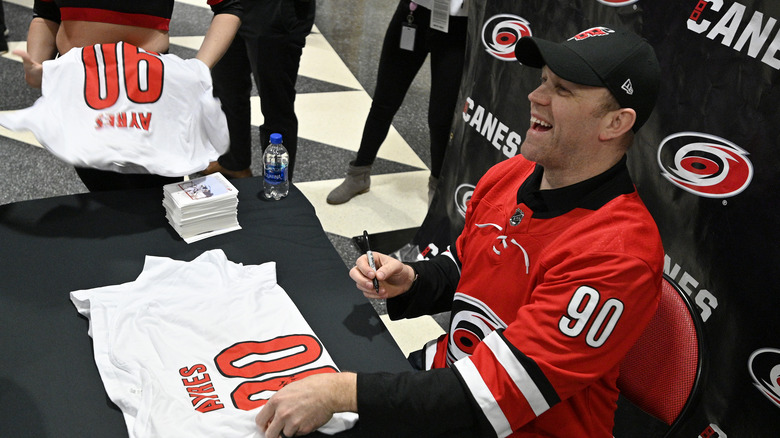The NHL's Unusual EBUG Rule Explained
Hockey is a dangerous game. Not "The Most Dangerous Game" — that's a short and a couple of movies — but still, there are a lot of ways to get hurt. Body checks, fisticuffs, 100-mile-per-hour slap shots traveling at head height all come to mind. Despite being wearing copious amounts of padding, goalies put their bodies on the line in hopes of keeping the puck out of the net. They'll put any part of their body they can in front of a flying piece of vulcanized rubber and perform incredible feats of contortion that would make most people whimper. All of this can lead to bodily harm, and unfortunately, it's not all that uncommon to see a goalie leave the game with an injury. Fortunately, the team have a backup goalie who throws on their blocker and glove and takes over the crease so the game can continue.
However, according to the NHL, each team is only allowed to dress two goaltenders for a game, so what happens if the backup goalie sustains an injury? It turns out that the league has thought of this and under the NHL rulebook —specifically Section 2, Rule 5.3 — if both of a team's listed goalies are incapacitated, "that team shall be entitled to dress and play any goalkeeper who is eligible." This is the rule that allows one of the more unusual moments that can occur in an NHL game: the use of an emergency backup goalie, or EBUG.
NHL roster rules
There are fairly strict rules governing the number of players an NHL team can keep on its active roster. According to the NHL, teams can have as many as 90 players on their reserve list, which is comprised of both signed and unsigned players. Each team is only allowed to have 50 players under contract each season, so the other 40 spots can be filled with drafted players who are unsigned, but the team still has the rights to them while they play in juniors, college, or overseas. Teams don't always reach the 50 required contracts to give general managers flexibility, but at least 24 players and three goalies must be under contract.
After the preseason, teams need to whittle their training camp rosters down to their 23-player active roster. After the trade deadline, teams can have an unlimited active roster as long the players on it are among the 50 they are allowed to have under contract.
Even when the active roster is capped at 23 players, a team may only dress 20 players for any given game, and this must be comprised of 18 skaters and two goalies. A list of these players must be submitted to the official scorer before the game. The strict rules regarding rosters — add to that the NHL's salary cap rules — can cause a headache for coaches and general managers, but the game must go on, and that's where emergency backup goalies come in.
The emergency backup goalie
Since the 2016-17 season, the National Hockey League requires every team to have an emergency backup goalie — an EBUG — on hand every night. This goalie is available to whichever team needs them, so while the home team is the one providing them, it's possible that they would have to go into service for the visitors. Some teams have multiple goalies that they go to, but only one is available each game. These players aren't paid but they get to attend NHL games for free.
According to DK Pittsburgh Sports, anyone can be an EBUG, although according to the league's collective bargaining agreement they "must not have a current contractual obligation elsewhere. In addition, the player cannot terminate an existing contractual obligation to meet this requirement." Of course, teams wouldn't pick someone who has never stepped on the ice before in their entire lives, and most EBUGs have experience playing at the high school, college, or club hockey levels. Before the EBUG rule, team personnel typically had to strap on pads if need be. In 2013, for instance, Florida Panthers goalie coach Rob Tallas — who was himself an NHL goalie — had to dress in two games, though he didn't see playing time.
If a team needs to call in an emergency backup goalie, they'll typically sign them to a tryout contract which allows them to exceed the 23-player active roster rule, but this is only allowed twice per season.
Have EBUGs ever been used?
It's one thing for the rule to exist. But have EBUGs ever actually been used? Yes, they have, although most of them don't end up seeing any actual playing time. In late 2021, the St. Louis Blues found themselves in a bind ahead of a road game against the Tampa Bay Lightning. Blues starter Jordan Binnington had to be placed in COVID-19 protocol, making him unavailable for the team. His backup, Ville Husso, was available and took the start, but the Blues were out of options for a backup netminder. According to the NHL, the Blues were up against the salary cap, and calling up a player from the American Hockey League — the top level of minor league hockey in North America — would have sent them over the cap. The Blues contacted the Lightning and got in touch with their backup goalie for that night, Kyle Konin. Konin took warmups with the Blues but was never put in the crease during regulation play and the Blues lost the game 4-2, per ESPN.
In 2016, Scott Foster — a full-time accountant by trade — was thrown into a game between the Chicago Blackhawks and the Winnipeg Jets. According to Slate, Foster stood between the pipes for 14 minutes, and during that time he posted seven saves without letting a single puck slip through the cracks, helping to lift the Blackhawks to a 6-2 victory.
David Ayers: The greatest EBUG story in NHL history
While EBUGs have become controversial over the years — with some, like the NHL To Seattle website, viewing the entire system as ridiculous — it has inarguably cooked up some incredible stories, perhaps none better than that of David Ayres. Ayres became the stuff of legend in February 2020 when he was called into action during a game at Toronto's Scotiabank Arena between the Maple Leafs and the visiting Carolina Hurricanes.
According to the NHL, Ayres was 42 years old at the time and worked as an operations manager at Mattamy Athletic Centre, formerly known as Maple Leaf Gardens. He also practiced with the Leafs and their American Hockey League affiliate, the Toronto Marlies, but the thought of being tossed into an actual NHL game seemed far-fetched. But, alas, it happened.
Carolina goalies James Reimer and Petr Mrazek both left with injuries, so the Hurricanes' net fell into the hands of David Ayres. Ayres was thrown into the game with nearly half of the regulation left to play, with the Hurricanes up 3-1. Once Ayres settled into the crease, the Canes got him some support by scoring to increase their lead by one, but then came a trial by fire when he faced the first shot of his NHL career, courtesy of Leafs' captain John Tavares, which went between Ayres' wickets and into the back of the net. Then Ayres let in a second goal. But after that, Ayres posted a clean sheet through the rest of the second period and into the third to give the Hurricanes a 6-3 victory (via ESPN).




